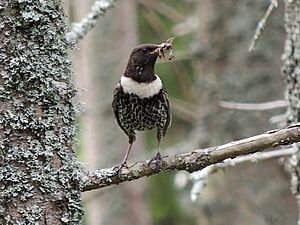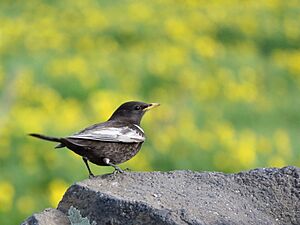Ring ouzel facts for kids
Quick facts for kids Ring ouzel |
|
|---|---|
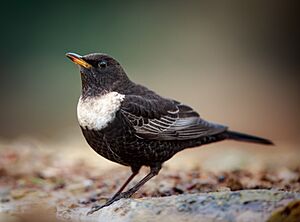 |
|
| A male Ring Ouzel in Spain | |
 |
|
|
|
| Conservation status | |
| Scientific classification | |
| Genus: |
Turdus
|
| Species: |
torquatus
|
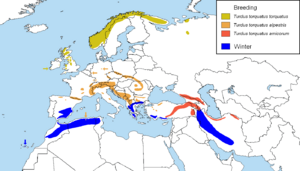 |
|
| Where Ring Ouzels live (approximate range) | |
The ring ouzel (Turdus torquatus) is a bird that lives mostly in Europe. It belongs to the thrush family, called Turdidae. This medium-sized thrush is about 23–24 cm (9–9.4 inches) long. It weighs between 90–138 grams (3.2–4.9 ounces).
Male ring ouzels are mostly black. They have a bright white crescent shape across their chest. Females are browner and less colorful than males. Young birds might not have this pale chest mark at all.
This bird usually lives in high mountains. It breeds in open mountain areas with some trees or bushes. These often include heather, conifers, beech trees, or juniper bushes. The ring ouzel is a migratory bird. This means it flies away for winter. It spends winter in southern Europe, North Africa, and Turkey. It prefers mountains with juniper bushes there.
A typical nest has 3–6 eggs. The eggs are pale blue or greenish-blue with brown spots. The female bird does most of the incubation. Eggs usually hatch after 13 days. The baby chicks are born without feathers and need a lot of care. They leave the nest after another 14 days. They depend on their parents for about 12 days after that.
Ring ouzels eat many different things. They are omnivorous. Their diet includes small creatures like insects and earthworms. They also eat some small vertebrates and many kinds of fruit. Most of their animal food is caught on the ground. In spring and during breeding season, they eat mostly small creatures. They also feed these to their chicks. Later in the year, fruit becomes more important. They especially like common juniper berries.
The ring ouzel lives in a very large area. It also has a big population. Because of this, the International Union for Conservation of Nature (IUCN) says it is a species of least concern. This means it is not currently in danger of disappearing. However, there are signs that their numbers are going down in some countries. Scientists think this might be due to climate change, people disturbing them, hunting, and outdoor activities. Losing juniper plants might also be a problem in some places. Other dangers include predators like mammals and birds of prey. Sometimes, other large thrushes like the common blackbird might compete with them for food or space.
Contents
What's in a Name?
"Ouzel" is an old word for the common blackbird. It is similar to the German word "Amsel." The name "Ring Ouzel" was first used a long time ago in 1674. It became well-known from a book about birds in 1678.
The scientific name also talks about the male's white neck ring. Turdus means "thrush" in Latin. Torquatus means "collared." So, the name means "collared thrush." People also have other old names for this bird. These include "fell blackbird," "hill blackbird," and "mountain blackbird."
Bird Family Tree: Taxonomy
The ring ouzel was first officially described in 1758. This was done by a famous scientist named Carl Linnaeus. He gave it the scientific name Turdus torquatus.
There are about 85 types of medium to large thrushes in the Turdus group. These birds usually have round heads and medium or long, pointed wings. They are also known for their beautiful songs.
Scientists studied the genetics of Turdus birds in 2020. They found that this group of birds started about 9.37 million years ago. They spread out from Africa and developed into different groups. The study suggests that the ring ouzel is closely related to other thrushes like Naumann's and dusky thrushes. It might be more related to them than to the common blackbird, even though they look similar.
Different Types of Ring Ouzels: Subspecies
The ring ouzel has three recognized subspecies (types):
- The northern ring ouzel (Turdus torquatus torquatus) lives in western and northern Europe. This includes places like Ireland and Scandinavia. It spends winter in southern Europe and northwest Africa.
- The Alpine ring ouzel (T. t. alpestris) breeds in mountain ranges. These stretch from Spain across central and southern Europe to Turkey. It also lives in North Africa. It winters in North Africa, southern Europe, and southern Turkey.
- The Caucasian ring ouzel (T. t. amicorum) breeds in central and eastern Turkey. Its range goes east to Turkmenistan. It mainly winters in Iran and parts of Iraq.
Studies of their DNA show that this bird used to live in a much wider area. This was after the last Ice Age, which ended about 11,700 years ago.
What They Look Like
The ring ouzel is about 23–24 cm (9–9.4 inches) long. It weighs between 90–138 grams (3.2–4.9 ounces).
The male bird is completely black. It has a clear white crescent shape on its chest. It also has narrow greyish scales on its upper body and belly. The edges of its wing feathers are pale. Its beak is yellow, and its legs are greyish-brown.
The female looks like the male but is browner. Her chest band is also duller. Young birds look like the female. However, their chest crescent is very faint or not there at all.
Adult ring ouzels are easy to spot because of their pale chest mark. Young ouzels can sometimes be confused with the common blackbird. But ring ouzels always have a paler patch on their wings.
The different subspecies have slight differences:
- Males of T. t. alpestris have wider white marks on their underparts. This makes them look scaly. Their wing patch is also paler.
- Males of T. t. amicorum have the biggest and whitest chest band. They also have wider white edges on their wing feathers. This forms a clear whitish patch on the wing.
Adult ring ouzels grow new feathers after breeding. This happens from late June to early September. Young birds also grow some new feathers between July and September.
Their Voice
The male ring ouzel sings from a low branch or sometimes while flying. Its song is a repetition of 2–4 sad, flute-like notes. It sounds like tri-ríí, tri-ríí, ti-ríí. There are pauses between each repeat.
Their call is a loud tac-tac-tac. This sound becomes harsher if the bird is scared. When they are flying, their contact call is a soft cherrr. Males sing most often at sunrise and sunset.
Where They Live and Travel
The ring ouzel breeds in different parts of Europe. This includes northwest Ireland, Scandinavia, and northwest Russia. It also breeds in mountains across central and southern Europe. These mountains stretch from the Pyrenees to the Alps, the Balkans, Greece, and Turkey.
These birds are migratory. They leave their breeding areas in September and October. Birds from northern Europe spend winter in southern Spain and northwest Africa. Other populations move south through the Swiss Alps. Eastern ring ouzels fly through the Balkans and Turkey. Some move south to Egypt. They return to their breeding areas mainly in March and April. Males usually arrive a few days before females. Many birds stop at grassy areas during their journey in spring and autumn.
The ring ouzel is no longer found breeding in Latvia. It only passes through Denmark during migration. It is also seen as a rare visitor in places like Iceland and the Arabian Peninsula.
In the middle parts of its range, the ring ouzel lives in mountains. But in the north, it lives in coastal uplands. It can handle wind and rain. However, it avoids ice and snow. They are usually found on open moorland with some small trees. This is often above 250 meters (820 feet) high. In Scotland, they can be found up to 1200 meters (3,900 feet). In other areas, they live on rocky slopes with heather, conifers, or juniper bushes. They can be found from sea level up to 3000 meters (9,800 feet) in some places.
In northwest Africa, ring ouzels spend winter in juniper forests. These are usually at 1800–2200 meters (5,900–7,200 feet) high. They are often near rivers or ponds. When migrating, they might be seen on coastal grasslands or steep hillsides.
How They Behave
The ring ouzel is territorial. This means it defends its own area. You usually see them alone or in pairs. However, they might form loose groups when they are migrating. When they are not breeding, several birds might gather in good feeding spots. This could be a tree full of fruit. They often join other thrushes like song thrushes.
The ouzel's flight is straight. They often sit on rocks or clumps of heather.
Reproduction and Life Cycle
Ring ouzels build nests from mid-April to mid-July in the Alps and British Isles. In Scandinavia, it's from May to August. They don't form large breeding groups. Instead, their territories might be spread out along streams.
The female bird builds the nest. It's a cup shape made of leaves, dry grass, and other plant material. She uses mud to make it strong. In western areas, nests are almost always on the ground. But in other places, they might build nests in small trees or bushes. These are usually about 3.5 meters (11 feet) high.
A nest usually has 3–6 eggs. The eggs are pale blue or greenish-blue with reddish-brown spots. Each egg is about 30 x 22 mm (1.2 x 0.87 inches) and weighs 7.4 grams (0.26 ounces). The female does almost all the incubation. The eggs usually hatch after 13 days. The baby chicks are born without feathers. They leave the nest after another 14 days. Young birds depend on their parents for about 12 days after they leave the nest.
Adult ring ouzels can breed after their first year. On average, they live for two years. However, one bird was recorded living for nine years! They might have two sets of babies in a year. This is more common in the southern parts of their range. These birds usually return to the same area to breed each year. About 36% of young birds survive their first year. For adults, about 47% of males and 37% of females survive each year. The main reasons they die are being caught by predators and accidents involving humans.
What They Eat
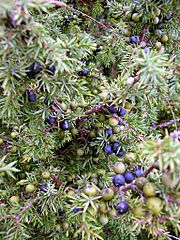
The ring ouzel is omnivorous. This means it eats many different things. It eats a variety of insects, earthworms, small amphibians, reptiles, and fruit. Most of the animals they eat are caught on the ground.
In spring and during breeding season, they mostly eat small creatures. These include earthworms, beetles, flies, ants, spiders, and snails. Later in the year, fruit becomes more important. They eat berries like bramble, strawberry, cherry, hawthorn, rowan, and juniper. When available, common juniper berries make up over 90% of their winter diet. Small creatures make up most of the rest. Because they eat so many juniper berries, ring ouzels help spread the juniper's seeds. They are very important for spreading the endemic Canary Islands juniper.
Young birds are mainly fed small creatures. Caterpillars and earthworms are big parts of their diet. When birds migrate in autumn, they use similar habitats as in spring. But seasonal berries make up most of their food then. They especially like elderberries, haws, and juniper berries.
Dangers and Health
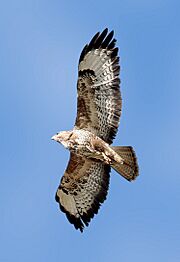
Animals that hunt ring ouzels include the tawny owl, long-eared owl, common buzzard, common kestrel, and Eurasian sparrowhawk. Mammals like least weasels and stoats also hunt them. Most deaths happen to young birds. Birds that hatch earlier in the season are more likely to survive. A study in Scotland showed that birds of prey caused 59% of deaths. Mammals caused 27%. In Romania, red squirrels and spotted nutcrackers took eggs.
Like other thrushes, the ring ouzel is rarely a host for the common cuckoo. Cuckoos are brood parasites. This means they lay their eggs in other birds' nests. But if the thrush's nest is too deep, the cuckoo chick can't push out the other chicks. If it does, the thrush parents might not feed it enough. Either way, the young cuckoo often starves.
A study in the Carpathian Mountains found that many ring ouzels had tiny mites. These mites can make birds sick if there are too many. A type of tick called Ixodes festai also often lives on thrushes, including the ring ouzel.
Protecting Ring Ouzels
The ring ouzel lives in a very large area. This area is estimated to be about 9.17 million square kilometers (3.54 million square miles). It also has a large population. There are an estimated 600,000 to 2 million individual birds in Europe. Europe makes up 95% of their breeding range.
The species is not considered to be in danger of a big population drop. So, the IUCN lists it as a species of least concern. This means it is not currently threatened. In 2019, there were an estimated 299,000–598,000 breeding pairs in Europe.
However, there are signs that their numbers are going down in some countries. In Ireland, their numbers have dropped a lot in recent years. Now, they only breed regularly in two counties. Scientists think the reasons for this decline include climate change, people disturbing them, hunting, and outdoor activities. Losing juniper plants might be a problem in southern Spain and northwest Africa. Planting too many trees in uplands might also affect them in the UK. There might also be competition from bigger thrushes. These include the common blackbird, mistle thrush, and fieldfare. A study in Scotland suggested that ring ouzels were less likely to leave higher areas with good heather cover. They were more likely to leave lower or more open places.
In the Alps, there can be many breeding pairs in one area. But generally, the numbers are much lower. For example, there are about 8 pairs per square kilometer (21 per square mile) in more open areas in Britain.



